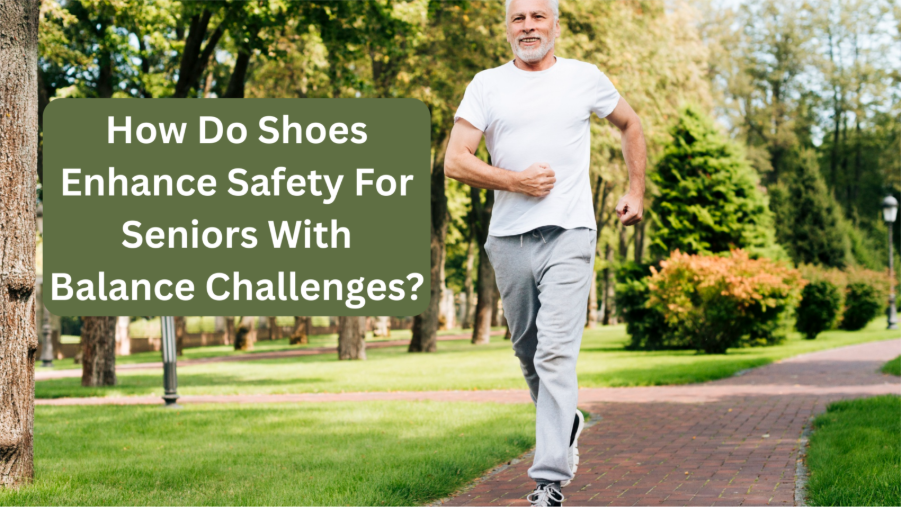Balance is often more difficult to maintain as we age.
Day-to-day activities such as walking to the mailbox, climbing a few steps or standing for a prolonged period may suddenly feel less steady. The risk of falls can be enhanced by joint pain, muscle weakness, or even poorly fitting shoes.
For the elderly, a simple fall can result in broken bones that take months to heal. Beyond being uncomfortable, it affects how you feel, your level of confidence and independence. A lot of people quit walking or socializing because they are afraid of falling.
This is where the proper pair of shoes comes in as a strong factor.
Shoes can either compromise stability or instead be seen as a means of increasing safety. Selecting supportive shoes can minimize stress on joints, enhance posture, and offer you a solid foundation to stand or walk on.
In this post, we’re going to discuss how the right type of shoes can help improve safety for seniors who have difficulties with balance.
1. Proper Traction Reduces Slip Risks
Shoes with a slip-resistant sole help prevent falls on smooth or wet surfaces.
Everyday situations frequently contain hidden dangers, such as polished flooring within the home, tiled bathrooms, and uneven outside walks. In such cases, shoes for elderly with balance problems that feature durable rubber outsoles with a strong tread pattern offer the necessary grip and support.
They improve traction so that each footstep can be a safer one, which provides confidence and allows seniors to have an active lifestyle without worrying about any slipping.
2. Cushioning Absorbs Shock and Protects Joints
Joints stiffen, arthritis, or cartilage wearing out are common with age.
Shoes with cushioned midsoles absorb impact as the foot hits the ground. This decreases the stress on the knees, hips and lower back. In the long term, good cushioning not just protects from pain, it also reduces fatigue while walking.
Cushioned shoes assist elders in staying mobile for extended periods of time by minimizing joint tension.
3. Wide Toe Boxes Improve Stability
Shoes that squeeze the toes interfere with the natural movement of the foot and destabilize it.
A broad toe box supports your toes to spread out comfortably and provide better ground contact. This improves stability and relieves the feet from unnecessary pressure. And for seniors with conditions like bunions or swelling, extra space in the forefoot also alleviates pain.
Stability begins with how firmly the feet connect to the ground, and a broad toe box reinforces that connection.
4. Lightweight Materials Prevent Fatigue
Heavy shoes may feel stable, but they often cause fatigue after a short period of walking. Lightweight designs reduce the energy needed for each step.
This matters because seniors with balance issues often rely on every ounce of strength to stay upright. Modern shoe technology allows footwear to be both light and supportive.
Less fatigue means longer, safer walks and more energy for daily activities.
5. Adjustable Closures Ensure Secure Fit
Loose-fitting shoes can slip off, while overly tight ones may restrict circulation.
Adjustable features such as Velcro straps, bungee laces, or simple tie systems let seniors customize their fit. A secure fit prevents shoes from shifting unexpectedly during movement, reducing the risk of trips.
For those with swelling feet or limited hand strength, adjustable closures also make wearing and removing shoes much easier.
6. Firm Heel Counters Add Extra Support
The heel area plays a central role in balance. Shoes with firm heel counters keep the foot aligned and stable during each step. Without proper support, the heel may wobble, throwing off balance and increasing fall risks.
A well-structured heel locks the foot in place, guiding proper posture and a steady gait. This design element often goes unnoticed but has a significant impact on walking confidence.
In addition, firm heel counters help prevent overpronation, which can strain ankles and knees, ensuring that each step feels controlled, safe, and well-supported for longer periods of walking.
7. Flexible Yet Supportive Soles Aid Natural Movement
Shoes must bend with the foot but not collapse under pressure. Flexible soles allow for a natural stride, while supportive construction maintains stability. This balance is especially important for seniors who need both comfort and safety.
Shoes that are too stiff may strain the legs, while overly soft soles can feel unstable. When the sole provides just enough give, walking feels smooth and controlled. Furthermore, this flexibility supports natural motion in the toes and midfoot, helping maintain circulation and reducing fatigue.
As a result, seniors can walk steadily and comfortably across varied surfaces without unnecessary stress.
8. Orthotic Compatibility Provides Customized Comfort

Every senior’s feet are different. Some may need arch support, while others require inserts for plantar fasciitis or flat feet.
Shoes designed to work with orthotics provide seniors with the flexibility to adjust comfort and stability according to their personal needs. Customizable support ensures that the shoe addresses both balance and health conditions.
With the right inserts, seniors can walk more comfortably and safely in almost any environment.
Conclusion
Balance challenges are a common part of aging, but they don’t have to limit independence.
The right shoes provide more than comfort—they actively enhance safety, stability, and confidence. From slip-resistant soles to orthotic compatibility, each design feature contributes to reducing fall risks and easing joint stress.
By paying attention to their footwear, seniors can continue to move freely, enjoy daily activities, and maintain a sense of security with every step.

